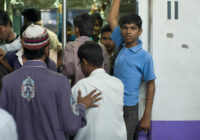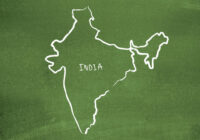Democracy in India is unique throughout the world. However, a new Indian Constitution is necessary. The current constitution is not suited for a sovereign, independent, and democratic nation of 1.2 billion people. This is the first of a two part series.
India is a country of continental proportions. Although it does not occupy a very large area, it is presently the second most populous nation in the world, next to China. If projections are to be believed, by 2050, it will be the most populated country on earth. The present population of India is around 1.2 billion, which is larger than the total population of Europe, the United States, and Canada put together. Moreover, the differences, divergences, and disparities among the people of various parts of India are comparable to the various European nations. Several major languages are spoken by millions of people. All the important religions of the world have followers by the million in India. Climate, dressing patterns, and food habits widely vary. The Indian Constitution unfortunately does not take this situation into account.
Partitioning India
It might be recalled that, prior to the partition of India, there were vigorous discussions between the British Government and the Indian political leadership — starting with the Cripp’s mission in 1941 until April 1947. The last round of talks were held between Indian leaders and Lord Louis Mountbatten, the governor general, from January to April 1947. By then, the British Government had announced that they would quit India by the end of June 1948. They also announced that if there was a consensus, they would transfer power as per the agreement. Otherwise, power would be transferred to individual provinces with the Indian states being ruled by local rajas and nawabs.
By April 1947, the governor general came to the conclusion that there was no possibility of agreement between the Indian National Congress and the Muslim League. The congress was opposed to partitioning the country, and the Muslim League insisted on a separate independent state consisting of Muslim-majority provinces. Therefore, the governor general called off all further negotiations and went to London for consultations with the British Government. After several weeks there, he returned to India and announced at the beginning of June that the country would be partitioned: power would be transferred to the Indian National Congress in India and to the Muslim League in Pakistan, and the British would withdraw from India by August 15, 1947 — a mere ten weeks from the time of announcement.
In light of demands by the Muslim League for the division of India, and similar demands of independence for Sikhs in Punjab and some of the tribal groups in the north-east, as well as calls for autonomy by the provinces, negotiations were generally based on two assumptions:
- The entire subcontinent, which was under British rule, would remain united as one nation.
- To allay the fears of various minority groups, the country’s constitution would provide for a weak centre which would deal with only subjects of common interest: defense, external affairs, currency, communications, and the provinces would retain all other subjects concerning governance and administration.
However, once partition was announced, leaders of the truncated nation (which was designated as the successor to the earlier British colony and hence named India), including Nehru, Patel, Azad and others, opted in favor of a strong centre and weak provinces. They were afraid that too much autonomy for the provinces might lead to further vivisection of the country. It was for this very reason that the Indian National Congress, which was earlier in favor of creating provinces on the basis of language such as Andhra, went back on its promise, fearing that such division of the country into linguistic states may also lead to demands for independence.
Therefore, when the constitution was finally framed, it opted for a strong centre and weak states. Some of the subjects, which were originally assigned to the states such as education, were later moved to the concurrent list which meant that the centre could also lay down education policy in the states. The centre retained control of most of the resources, both natural and financial, and reduced the states to a client status. More than 60 years of operating the Indian constitution has brought out several important defects to shine.
Centralized Administration
First and foremost, the administration is highly centralized with almost every important subject dealing with individual citizens being vested — either solely or jointly — with the centre. In a country of 1.2 billion people, such a concentration of power in the centre’s hands is not only undesirable, but it renders decision making quite opaque.
Transparency would be possible only if decision making is highly decentralized. In this context, it should be noted that even states have large populations comparable to, or in excess of, many nations of Europe.
It is necessary to decentralize administration down to the level of districts. With about 700 districts in the country, the average population of a district is approximately 1.8 million. In fact, there are districts with populations in excess of 3.5 to 4 million, which is comparable to the populations of whole nations in Europe and South America. Transparency in decision making will pave the way for the elimination of corruption. It will also ensure that the administration is responsive to local needs of the population.
Too Many Constituents
Even India’s representative institutions like the Lok Sabha and Legislation Assemblies are not able to effectively represent the large sized constituencies. On average, a member of Lok Sabha represents more than 2.2 million people, of whom about 1.4 million will be voters. If we compare this to an MP representing around 100,000 people in the United Kingdom, it is clear that the task for Indian MPs to represent such a large population is near impossible. Even at the state level there is one Member of the Legislative Assembly (MLA) for 500,000 in Uttar Pradesh. Thus, even India’s MLA’s are not able to really represent and address the problems of all the people in their constituency. Real democracy will not be possible unless, once again, we have a highly decentralized system of governance.
Uniformed Policy
Reference has already been made to the wide variations, divergences, and disparities among the different states of the union. Even historically, the east, west, and south of India came under the influence of the western liberal ideas nearly a century before the rest of the country. This is reflected in the general attitude of people to various social issues.
In light of this, it is difficult, if not impossible, to enunciate and implement a uniformed policy effecting the people of different regions. Whether it is Sarva Siksha Abhiyan, the National Rural Health Mission, or any other such scheme, its applicability in different states of the union is not the same. There are not only regional disparities but also different regional priorities and sometimes conflicts of interest between neighboring states. All these problems once again point to the need for decentralization.
Regional interests and priorities being different have given rise to regional political parties all over the country. Even national parties like the Indian National Congress, the BJP, and communists have been reduced to regional parties with strong presences in certain states, while being completely wiped out in others. This has led to the fragmentation of Lok Sabha where nearly 40 regional and national parties are represented.
A coalition government has became inevitable under these circumstances; while such coalitions manage bare majorities in the Lok Sabha. This has led to small partners of a coalition holding the government to ransom and dictating to them whether a given policy should be adopted. The rise of regional parties and the formation of coalition governments was not envisaged by the architects of the Indian constitution. But given the size of the populations in the states, their diversity and divergences, it was inevitable that regional interests and priorities would be different and even conflicting. A highly centralized administration cannot cater to such differences. This is reflected in the way parliament is functioning or not functioning with regional interests in conflict with national policy.
It should be realized that Indian democracy is unique in the world. Trying to build a government of the people, by the people and for 1.2 billion people of diverse languages, cultures, religions, and so on has not been easy. There is no parallel to the Indian democracy from which we can draw lessons. It is left to Indians to invent and innovate a system of government at the centre, and states that reflect the desires and aspirations of people around the country. Strong states with a client centre that only deal with subjects of common interest is the best way to ensure democratic unity in diversity. Even within the states, power should devolve down to the district and panchayat level. An entirely new Indian constitution has to be devised. The current one is certainly not suited for a sovereign, independent, and democratic nation of 1.2 billion people.
*Read the final part of “Governing India” on June 3.
The views expressed in this article are the author’s own and do not necessarily reflect Fair Observer’s editorial policy.
Image: Copyright © Shutterstock. All Rights Reserved
Support Fair Observer
We rely on your support for our independence, diversity and quality.
For more than 10 years, Fair Observer has been free, fair and independent. No billionaire owns us, no advertisers control us. We are a reader-supported nonprofit. Unlike many other publications, we keep our content free for readers regardless of where they live or whether they can afford to pay. We have no paywalls and no ads.
In the post-truth era of fake news, echo chambers and filter bubbles, we publish a plurality of perspectives from around the world. Anyone can publish with us, but everyone goes through a rigorous editorial process. So, you get fact-checked, well-reasoned content instead of noise.
We publish 2,500+ voices from 90+ countries. We also conduct education and training programs
on subjects ranging from digital media and journalism to writing and critical thinking. This
doesn’t come cheap. Servers, editors, trainers and web developers cost
money.
Please consider supporting us on a regular basis as a recurring donor or a
sustaining member.
Will you support FO’s journalism?
We rely on your support for our independence, diversity and quality.







Comment